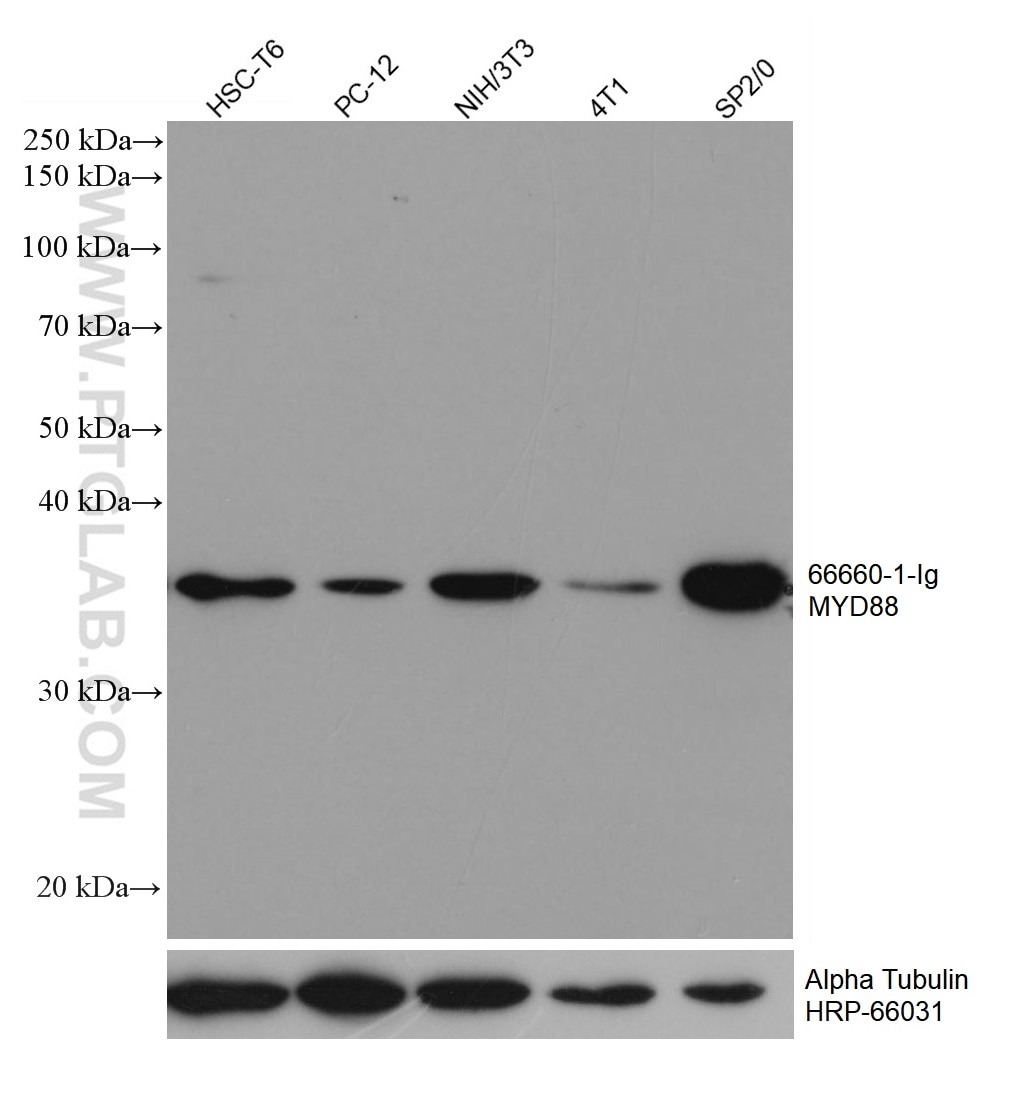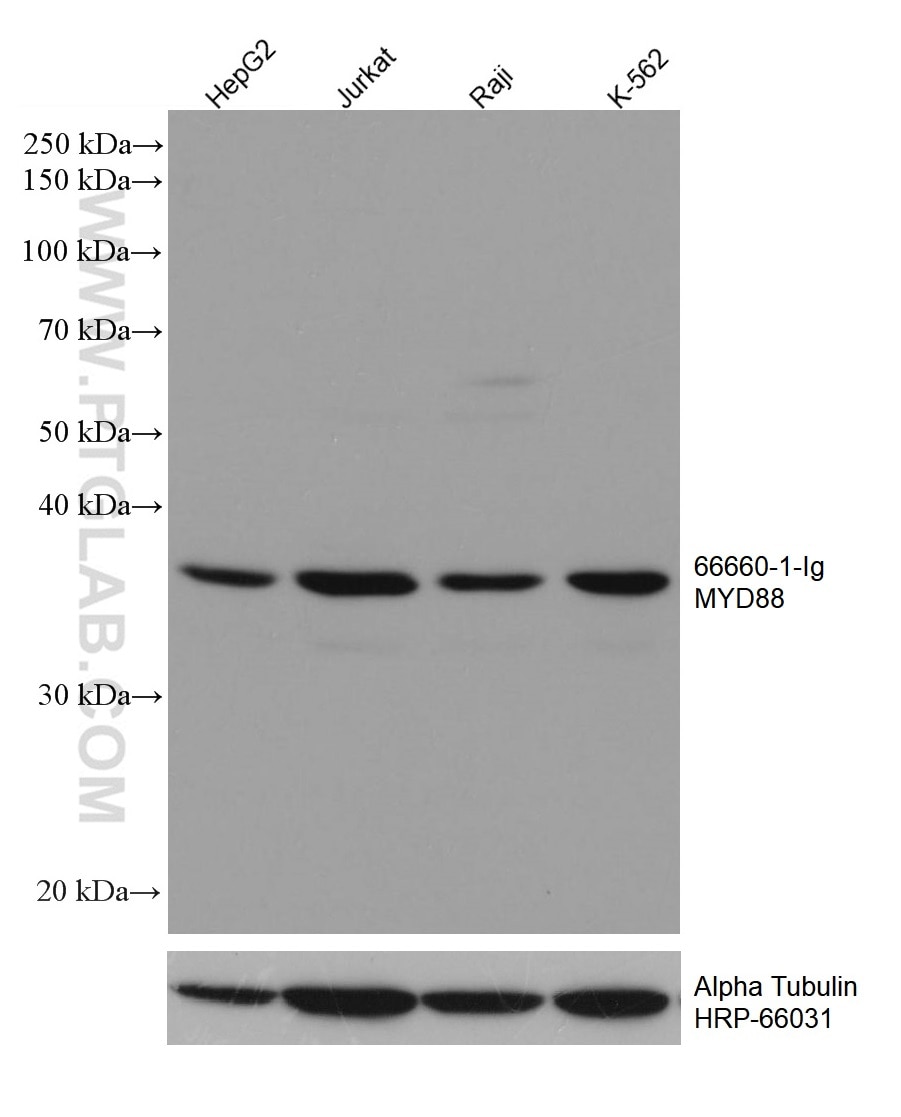Validation Data Gallery
Tested Applications
| Positive WB detected in | HSC-T6 cells, HepG2 cells, PC-12 cells, NIH/3T3 cells, 4T1 cells, SP2/0 cells |
Recommended dilution
| Application | Dilution |
|---|---|
| Western Blot (WB) | WB : 1:2000-1:10000 |
| It is recommended that this reagent should be titrated in each testing system to obtain optimal results. | |
| Sample-dependent, Check data in validation data gallery. | |
Published Applications
| WB | See 9 publications below |
| IHC | See 1 publications below |
Product Information
66660-1-Ig targets MYD88 in WB, IHC, ELISA applications and shows reactivity with Human, rat, mouse samples.
| Tested Reactivity | Human, rat, mouse |
| Cited Reactivity | human, mouse |
| Host / Isotype | Mouse / IgG1 |
| Class | Monoclonal |
| Type | Antibody |
| Immunogen |
CatNo: Ag19770 Product name: Recombinant human MYD88 protein Source: e coli.-derived, PGEX-4T Tag: GST Domain: 1-150 aa of BC013589 Sequence: MAAGGPGAGSAAPVSSTSSLPLAALNMRVRRRLSLFLNVRTQVAADWTALAEEMDFEYLEIRQLETQADPTGRLLDAWQGRPGASVGRLLELLTKLGRDDVLLELGPSIEEDCQKYILKQQQEEAEKPLQVAAVDSSVPRTAELAGITTL 相同性解析による交差性が予測される生物種 |
| Full Name | myeloid differentiation primary response gene (88) |
| Calculated molecular weight | 33 kDa |
| Observed molecular weight | 33-36 kDa |
| GenBank accession number | BC013589 |
| Gene Symbol | MYD88 |
| Gene ID (NCBI) | 4615 |
| Conjugate | Unconjugated |
| Form | |
| Form | Liquid |
| Purification Method | Protein G purification |
| UNIPROT ID | Q99836 |
| Storage Buffer | PBS with 0.02% sodium azide and 50% glycerol{{ptg:BufferTemp}}7.3 |
| Storage Conditions | Store at -20°C. Stable for one year after shipment. Aliquoting is unnecessary for -20oC storage. |
Background Information
Background
Myeloid differentiation primary response 88 (MYD88) is an adapter protein critical to the innate and adaptive immune response.
What is the molecular weight of MYD88?
The molecular weight of MYD88 is 33 kDa.
What is the cellular localization of MYD88?
The subcellular localization of MYD88 is largely confined to the cytoplasm as condensed forms or aggregated structures.
What is the role of MYD88 in the IL-1R signaling pathway?
MYD88 plays a major role in the inflammatory signaling pathways downstream of Toll-like receptor (TLR) and interleukin-1 receptor (IL-1R) families. MYD88 links these receptors to IL-1R-associated kinases (IRAK), such as IRAK1 and IRAK2, via protein-protein interactions. The C-terminal TIR domain of MYD88 mediates the interaction with the receptors, whereas the N-terminal death domain of MYD88 associates with IRAK family members (PMID: 25580251). MYD88 acts via its intermediate domain to phosphorylate and thus activate IRAK1, IRAK2, IRF7, and TRAF6 to trigger NF-kappa-B signaling and cytokine secretion as part of the inflammatory response (PMID: 19679662).
What is MYD88's involvement in disease?
Defects in MYD88 due to deficiency of the protein leads to recurrent pyogenic bacterial infections, including invasive pneumococcal disease. Patients usually die between 1 and 11 months of age, but surviving patients are otherwise healthy with normal resistance to other microbes (PMID: 18669862). Mutations in the MYD88 gene also lead to the development of cancers such as lymphoma (PMID: 21179087) and some autoimmune disorders like ulcerative colitis (PMID: 24189845).
Protocols
| Product Specific Protocols | |
|---|---|
| WB protocol for MYD88 antibody 66660-1-Ig | Download protocol |
| Standard Protocols | |
|---|---|
| Click here to view our Standard Protocols |
Publications
| Species | Application | Title |
|---|---|---|
ACS Nano Bacteria-Anchoring Hybrid Liposome Capable of Absorbing Multiple Toxins for Antivirulence Therapy of Escherichia coli Infection. | ||
Theranostics Fibrinogen-like protein 2 aggravates nonalcoholic steatohepatitis via interaction with TLR4, eliciting inflammation in macrophages and inducing hepatic lipid metabolism disorder. | ||
Food Funct Salvianolic acid B prevents body weight gain and regulates gut microbiota and LPS/TLR4 signaling pathway in high-fat diet-induced obese mice. | ||
Pharm Biol Catalpol relieved angiotensin II-induced blood–brain barrier destruction via inhibiting the TLR4 pathway in brain endothelial cells | ||
Life Sci Salvianolate reduces neuronal apoptosis by suppressing OGD-induced microglial activation. | ||


